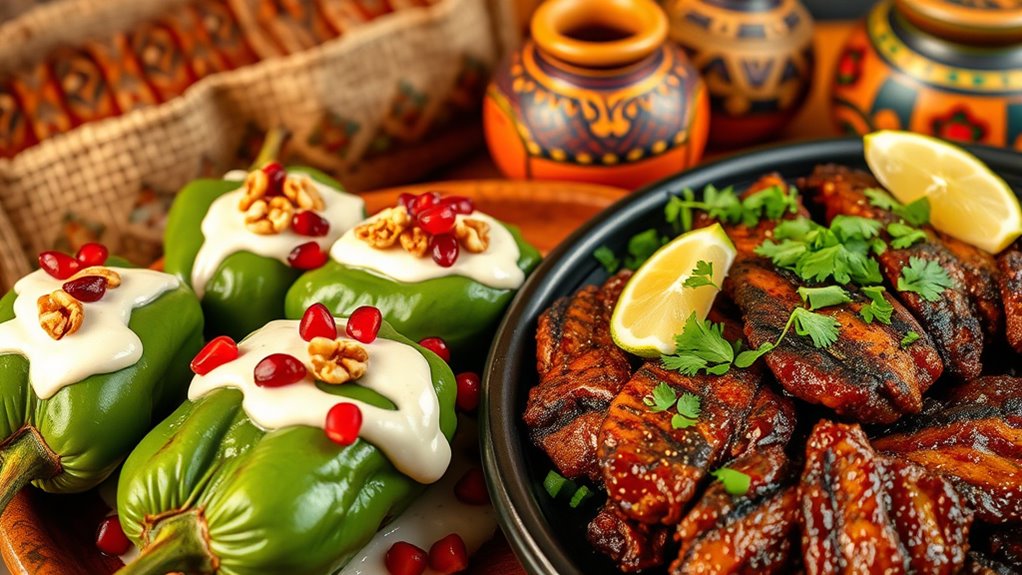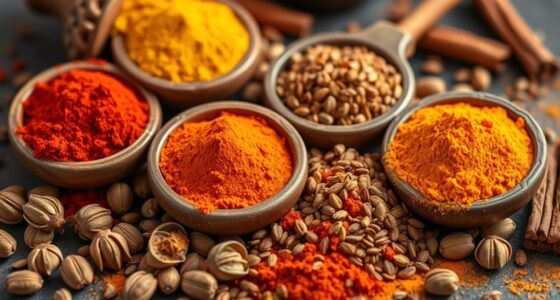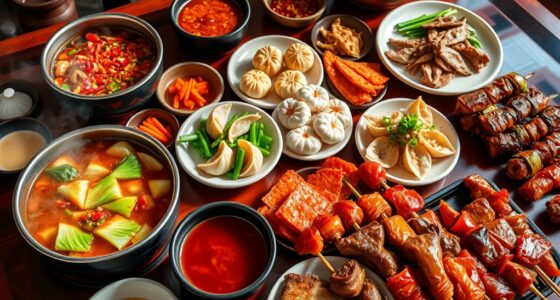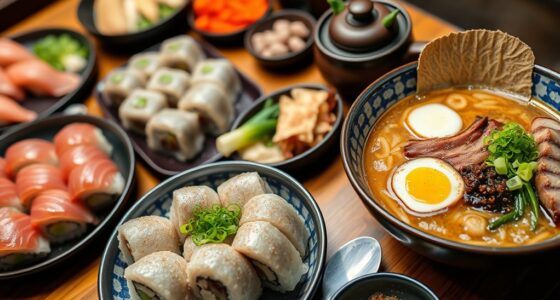Mexican food is so much more than just tacos. It features vibrant flavors from fresh ingredients like corn, beans, chiles, and herbs like cilantro and cumin. Regional influences shine through, from spicy Yucatán dishes to seafood by the coast, with traditional techniques adding depth and authenticity. Every bite tells a story of history, community, and culture. If you keep exploring, you’ll uncover the diverse ingredients, preparation methods, and rich traditions that make Mexican cuisine truly unique.
Key Takeaways
- Mexican cuisine features diverse regional dishes beyond tacos, such as mole, tamales, and ceviche.
- It emphasizes fresh ingredients like corn, beans, chiles, and avocados, used in a variety of traditional preparations.
- Herbs like cilantro, cumin, and oregano create layered, authentic flavors across many dishes.
- Traditional methods like slow-cooking and fermenting develop rich, complex textures and tastes.
- Food is culturally significant, often telling stories of history, community, and regional identity.
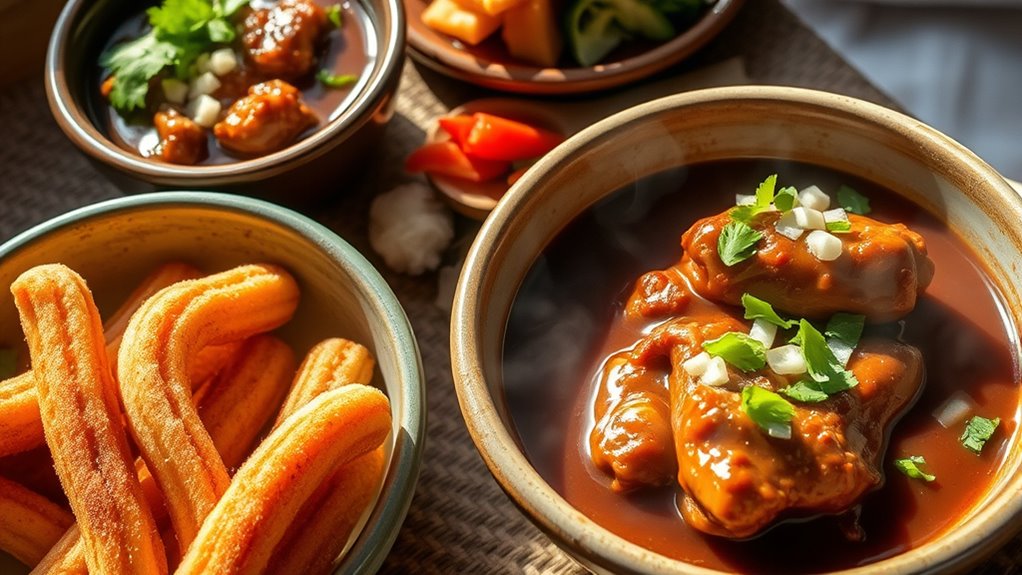
Have you ever wondered what makes Mexican food so vibrant and flavorful? It’s not just about the tacos you see on every street corner; it’s a rich tapestry of history, culture, and ingredients that come together to create a truly unique culinary experience. When you immerse yourself in Mexican cuisine, you’re exploring a world where every dish tells a story, from ancient traditions to modern innovations. You might think of tacos first, but Mexican food extends far beyond that, encompassing a wide variety of ingredients and techniques that make each dish special.
At its core, Mexican cuisine relies heavily on fresh, local ingredients. You’ll find an abundance of corn, which forms the basis of staples like tortillas, tamales, and pozole. Corn isn’t just a food source; it’s a cultural symbol, deeply rooted in Mexican identity. You’ll also notice the frequent use of beans, chiles, avocados, and tomatoes, which add layers of flavor and texture to countless dishes.
Mexican cuisine is rooted in fresh, local ingredients like corn, beans, chiles, avocados, and tomatoes that define its vibrant flavors.
The use of herbs and spices like cilantro, cumin, and oregano enhances each bite, creating a balance of heat, earthiness, and freshness that’s hard to find elsewhere. Attention to detail in preparation methods is also key to achieving authentic flavors.
Mexican cooking is also defined by its diverse regional influences. For example, in the Yucatán Peninsula, you’ll encounter dishes flavored with achiote and lime, giving them a vibrant, tangy profile. In the northern states, meat plays a more prominent role, with beef, goat, and chicken used in hearty stews and grilled dishes. The coastal regions emphasize seafood, preparing fish and shellfish with bright citrus and chili sauces.
This regional diversity means that when you explore Mexican food, you’re not just tasting one style but a spectrum of flavors and techniques, each reflecting local history and climate.
Preparation methods are equally important. You might be surprised to learn how traditional techniques like slow-cooking meats in underground pits or fermenting ingredients to develop complex flavors are still used today. Many dishes involve a careful balancing act—combining smoky, spicy, tangy, and savory elements to create harmonious bites.
Salsas, for instance, aren’t just condiments; they’re integral to the dish, adding layers of flavor and heat that elevate the meal.
In essence, Mexican food is more than just tacos; it’s a celebration of ingredients, history, and culture that invites you to explore a world of bold flavors and traditions. When you truly taste it, you discover a cuisine that’s deeply rooted in community and storytelling, offering much more than meets the eye.
Frequently Asked Questions
What Are the Regional Variations of Mexican Cuisine?
You’ll find that Mexican cuisine varies greatly by region, offering unique flavors and dishes. In the north, you might enjoy hearty beef and goat dishes.
Meanwhile, the south features rich, mole sauces and tropical fruits. Coastal areas focus on seafood, providing fresh and flavorful options.
Central regions highlight traditional staples like corn, beans, and chilies. These differences reflect local ingredients, climate, and cultural influences, making Mexican food a diverse and exciting culinary experience.
How Has Mexican Food Influenced Global Culinary Trends?
You might think Mexican food is just tacos, but it’s actually a culinary powerhouse shaping global trends. From fusion dishes blending salsas with sushi to inventive uses of chili peppers, Mexican flavors inspire chefs worldwide.
You can’t ignore how ingredients like avocado and cilantro have become staples everywhere. So next time you enjoy guacamole or spicy salsa, remember, you’re part of a delicious cultural revolution that’s transforming kitchens globally.
What Are Traditional Mexican Beverages Besides Tequila?
When you explore traditional Mexican beverages beyond tequila, you’ll discover options like aguas frescas, which are invigorating fruit or flower-infused waters.
You might also try mezcal, a smoky spirit similar to tequila but with a richer flavor.
Don’t miss atole, a warm, comforting drink made from corn masa, or pulque, a fermented beverage with ancient roots.
These drinks showcase Mexico’s diverse and vibrant culinary heritage.
How Do Mexican Cooking Techniques Differ Across Regions?
You’ll find that Mexican cooking techniques vary widely across regions. In the north, grilling and roasting meats are common, reflecting cowboy influences.
Central Mexico emphasizes slow cooking methods like braising, especially for dishes like mole.
Coastal areas focus on seafood preparations such as ceviche and steaming.
In the Yucatán, you’ll notice the use of underground pit cooking called ‘pib,’ showcasing indigenous traditions.
These regional techniques create diverse, authentic flavors across Mexico.
What Is the History Behind Popular Mexican Dishes?
When you explore the history behind popular Mexican dishes, you discover a rich mix of indigenous ingredients and Spanish influences.
You’ll see how ancient civilizations like the Aztecs and Maya used maize, beans, and chili, shaping dishes like tamales and pozole.
Spanish colonization introduced new techniques and ingredients, blending traditions to create the diverse cuisine you enjoy today.
This history reflects Mexico’s vibrant cultural evolution and culinary resilience.
Conclusion
Mexican food isn’t just a meal; it’s a vibrant tapestry woven with bold flavors and rich traditions. As you dive beyond tacos, you discover a symphony of spices and textures that dance on your palate, inviting you into a world bursting with history and passion. So, let each bite be a passport to Mexico’s soul—an exhilarating journey where every dish tells a story and every flavor paints a masterpiece.
